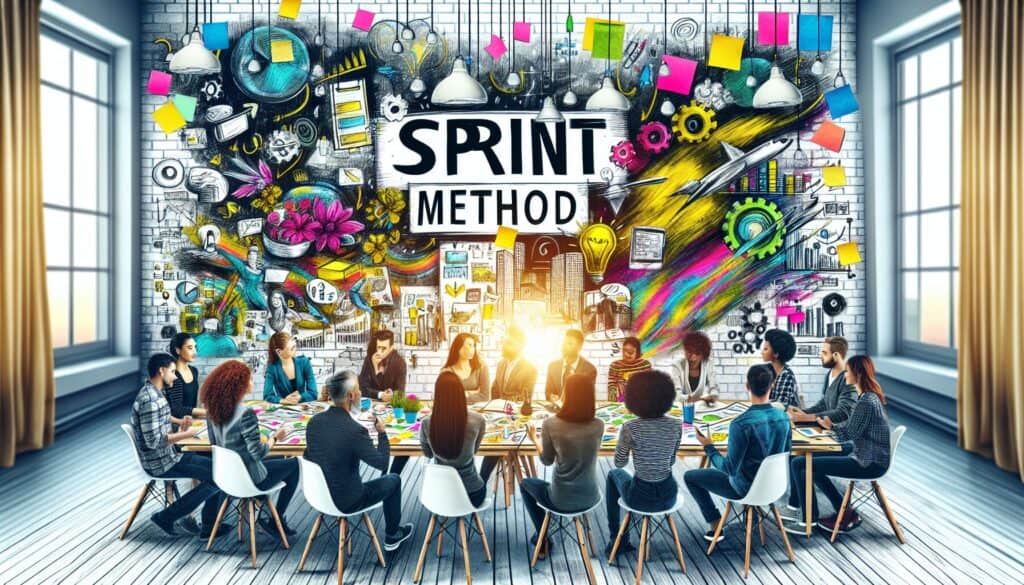Resolver rápidamente grandes retos, crear nuevos productos o mejorar los existentes mediante una colaboración intensiva y limitada en el tiempo (normalmente 5 días), la creación de prototipos y la realización de pruebas con los usuarios.
- Metodologías: Ingeniería, Resolución de problemas, Calidad
Método Sprint (Sprint de diseño)

Método Sprint (Sprint de diseño)
- Metodología ágil, Colaboración multifuncional, Sprint de diseño, Pensamiento de diseño, Innovación, Creación de prototipos, Creación rápida de prototipos, Pruebas de usuario, Diseño centrado en el usuario
Objetivo:
Cómo se utiliza:
- Un proceso estructurado en cinco fases: Entender (trazar el problema, elegir un enfoque), Esbozar (generar soluciones generales), Decidir (seleccionar las mejores soluciones), Prototipar (construir un prototipo realista) y Probar (obtener comentarios de usuarios reales).
Ventajas
- Resultados rápidos, centrados en el usuario, reducen el riesgo de crear el producto equivocado, fomentan la alineación y colaboración del equipo, resultados tangibles (prototipos y resultados de pruebas).
Contras
- Requiere mucho tiempo de dedicación por parte de un equipo multifuncional, puede ser intenso y agotador, el éxito depende en gran medida de las habilidades del facilitador y de la participación del equipo, puede no ser adecuado para todo tipo de problemas (por ejemplo, investigaciones muy complejas y a largo plazo).
Categorías:
- Clientes y marketing, Ideación, Resolución de problemas, Diseño de producto, Gestión de proyectos
Ideal para:
- Validación de ideas de productos, diseño de nuevas funciones, resolución de problemas complejos, etc. desafíos de diseñoy fomentando la innovación en un plazo breve con información clara y práctica de los usuarios.
The Sprint Method, particularly in design contexts, is widely applicable in technology and product development sectors, including software engineering, consumer electronics, and health tech, where rapid prototyping and iterative testing can significantly influence market readiness. Organizations engage cross-functional teams, including designers, engineers, product managers, and stakeholders, to initiate sprints, ensuring diverse perspectives contribute to identifying and addressing user needs. This methodology is especially effective during the ideation and early development phases of project lifecycles, allowing teams to validate or pivot ideas before heavy investments are made. For instance, a software company might use a design sprint to refine a mobile app feature by rapidly constructing a prototype to test with actual users, which leads to actionable feedback that informs further development. By condensing a potentially lengthy development cycle into a focused week, teams can quickly assess the viability of their concepts, which can lead to reduced time-to-market. The collaborative nature of sprints not only aligns team members toward common goals but also cultivates a shared understanding of customer needs and expectations, thereby enhancing the likelihood of product-market fit. Successful application of this methodology has been documented in top-tier organizations such as Google and LEGO, illustrating its effectiveness in diverse industries and enhancing innovation capacity.
Pasos clave de esta metodología
- Map out the problem and identify a specific focus.
- Generate a variety of potential solutions through sketching.
- Select the most promising solutions for further development.
- Create a realistic prototype representing the chosen solutions.
- Test the prototype with real users to gather feedback.
Consejos profesionales
- Involve cross-functional team members early to ensure diverse perspectives are incorporated and align on objectives swiftly.
- Prioritize user feedback by engaging with a target audience representative in the testing phase to obtain actionable insights.
- Document every phase comprehensively to facilitate reflection and iterative improvements for future sprints and projects.
Leer y comparar varias metodologías, recomendamos el
> Amplio repositorio de metodologías <
junto con otras más de 400 metodologías.
Sus comentarios sobre esta metodología o información adicional son bienvenidos en la dirección sección de comentarios ↓ , así como cualquier idea o enlace relacionado con la ingeniería.
Contexto histórico
1949
1950
1950
1960
1960
1960
1960
1940
1950
1950
1958
1960
1960
1960
1960
(si se desconoce la fecha o no es relevante, por ejemplo "mecánica de fluidos", se ofrece una estimación redondeada de su notable aparición)















Publicaciones relacionadas
Cuestionarios sobre molestias musculoesqueléticas
Pruebas multivariantes (MVT)
Análisis de regresión múltiple
Sistemas de captura de movimiento
Método MoSCoW
Prueba de la mediana de Mood